GTI Project Update: Smooth Criminal
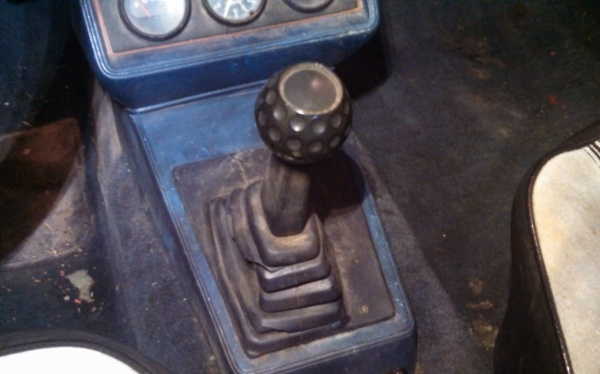
Now that our Rabbit can move under its own power, it’s time to address some of the finer details. As we have mentioned, the shift pattern was so vague that you couldn’t tell which gear you were in most of the time. The twenty year old tires were also making us a little nervous and the noise caused by the three inch hole in the muffler was grating. Hopefully with a a few days of work we can turn this GTI into one smooth sounding and shifting criminal.
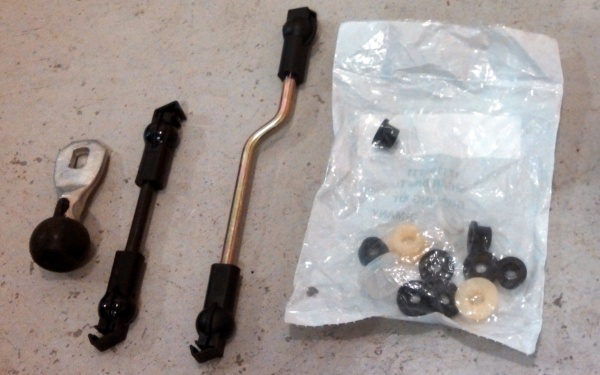
In our search for parts we found a company called MK1 Autohaus. They sell lots of oem stuff for MK1 Volkswagens and they even manufacture a few things themselves. Parts for these early VWs are starting to get hard to find, so we were happy to stumble across these guys. We ordered up a shift linkage rebuild kit and a new pivot bearing.
Replacing all the rubber washers, bushings, and arms only took an afternoon. It wasn’t a hard job, but it did require some feeling around in the dark since most of the linkage is located on the upper backside of the transmission. We also took it apart in sections to keep from mixing anything up. Trying to piece it all back together even with a diagram would have been a real challenge. We cleaned and re-greased everything as we went. Then we replaced our trashed pivot bearing from inside the car and screwed the golf ball shift knob back on.
The shift pattern is now defined and the movement smooth. The throws are long, but each gear is close and easy to find. Now that the sloppy shift linkage was fixed, we really wanted to take the GTI out for a longer drive than around the block. We figured we had better replace at least two of the oldest tires though before attempting anything too rigorous.
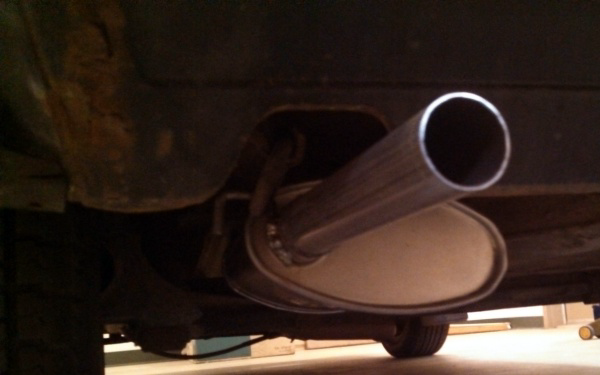
While at the tire shop, we also had the guys take a look at our muffler. We were tired of the glances from fellow motorists who assumed we were making all that noise on purpose. They welded up a shiny new one and we were on our way feeling a little less embarrassed and hearing a whole lot better.
We were excited for the drop in decibel level, but by shutting up the exhuast we just made all the other obnoxious sounds more noticeable. As we have said before, once you fix a glaring issue, you are bound to discover more problems that need fixing. Now we could hear that engine wasn’t running too well. New plugs, wires, and fuel filter helped a lot, but it was obvious that we were going to have go through the fuel injection and emissions systems.
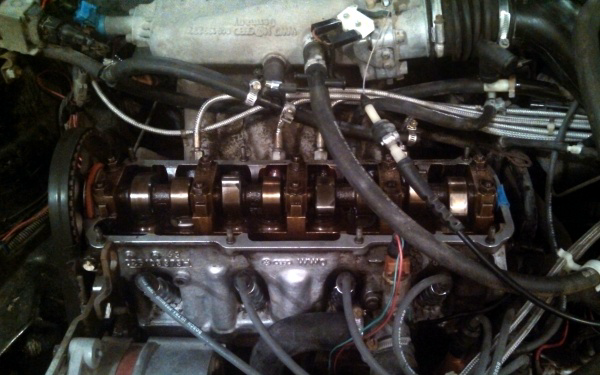
Reduced emissions and better fuel economy are great things, but boy does the required equipment makes things complicated under the hood. When the fuel system gets dirty or there is a vacuum leak, diagnosing problems can become a real challenge. We dumped Sea Foam in a fresh tank of gas to start cleaning things up inside and then used some carb cleaner to check for leaks. We were able to find a few leaks under the intake. New o-rings on the injectors and a valve cover gasket seemed to help, but the engine still cuts out when the accelerator is dropped.
Here is a video of the engine running. It starts right up even on a cold day like today, but it is far from being a smooth criminal yet. It idles a little high and obviously doesn’t like being revved. We have already tested the cold start injector to make sure it wasn’t leaking and have replaced the O2 sensor. We can’t locate any other obvious vacuum leaks so we have a fear it could be a faulty fuel distributor. Any Audi or VW experts here who can help us diagnose the problem?
The next Barn Finds project is going to be carbureted…
| Part | Price |
| Car | $ 400 |
| Battery | $ 60 |
| Half-shaft | $ 60 |
| Half-shaft Bolts | $ 30 |
| Oil Filter | $ 8 |
| Air Filter | $ 6 |
| Dip Stick Funnel | $ 4 |
| Hood Release | $ 23 |
| Wheel Hub | $ 30 |
| Ball Joints | $ 17 |
| Lug Bolts | $ 40 |
| Wheel Bearing | $ 35 |
| Strut Cartridges | $ 57 |
| Strut Bump Stops | $ 6 |
| Metal Collar (Ace) | $ 2 |
| Ignition Switch | $ 12 |
| Linkage Rebuilt Kit | $ 29 |
| Pivot Bearing | $ 39 |
| 2 Tires + Mounting | $ 144 |
| Muffler + Installation | $ 158 |
| Spark Plugs | $ 11 |
| Wire Set | $ 32 |
| Oxygen Sensor | $ 16 |
| O-Ring Kit | $ 2 |
| Valve Cover Gasket | $ 9 |
| Total | $ 1,230 |
Find the next segment of the story here!
Read all the updates on our GTI project:
Auctions Ending Soon
 2002 Subaru Impreza WRXBid Now2 days$333
2002 Subaru Impreza WRXBid Now2 days$333
 1975 Chevrolet Corvette ConvertibleBid Now2 days$4,000
1975 Chevrolet Corvette ConvertibleBid Now2 days$4,000
 1964 Ford F-100 Camper CustomBid Now2 days$2,000
1964 Ford F-100 Camper CustomBid Now2 days$2,000
 2006 Jeep Wrangler SportBid Now4 days$10,500
2006 Jeep Wrangler SportBid Now4 days$10,500
 1974 Datsun 260ZBid Now6 days$750
1974 Datsun 260ZBid Now6 days$750
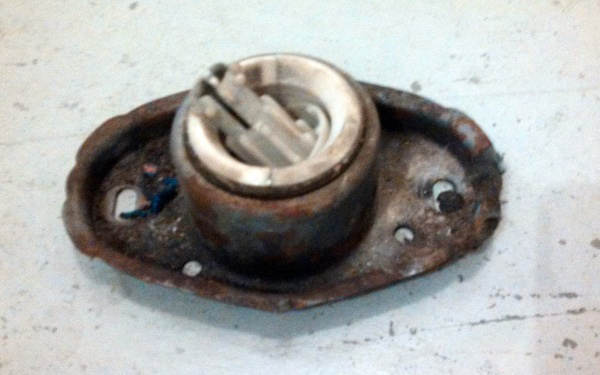

Comments
Oh, I forgot to mention that we did a compression test before we did anything and it was good on across all cylinders. Not perfect, but that is not the problem here. We also checked the timing belt, but have not messed with the timing yet.
Surprise!! You still have a Volkswagen!
this may seem a tad elementary but did you check and make sure the plus wires are correct and 2 of them are not switched?
Fuel system issues for sure. Go after the fuel filter also do a fuel pressure test you should have something like 60 Bar on the motronic. That’s my thought.
Also, run a bottle of Lucas fuel system cleaner through with every tank for about the next three tanks of fuel. That will make a noticeable difference in the idle, acceleration and smoothness.
Don’t wait to change the timing belt and tensioner. They are probably original and are well past their perish dates. The valves are not an interference fit but if the timing belt breaks you won’t be going anywhere. I had trouble with my EGR valve in my ’79 – They are hard to find and expensive if you do find a new one. Look for a good used unit. CIS is sensitive to vacuum leaks so check all the boots and hoses for cracks or holes. Don’t forget the distributor cap, rotor, and plug wires.
i would check the catalytic converter to see if it is clogged or collapsed. then since it has a distributor i would go there next. both are less costly than a fuel distributor.
Also consider having the injectors profesionally cleaned and flow tested. Nice to see you bringing this one back from the dead. GTI’s are the original hot hatch…very nice.
Maybe the throttle position sensor?
nice to hear the engine run even if it is rough. i did not hear any bad noises like bearings. glad you can drive it as that makes all the work worth it. i always found the turning point was when the engine ran and car could be driven. the rest is just details. on the carbureted project be very glad this not a first year rabbit with one!
This may sound a bit obvious, but have you checked the advance mechanism in the distributor and lubricated it yet? It’s a fairly easy check to see if the rotor moves freely and snaps back after turning it, and it is likely that the old grease that once kept it free has now got the consistency of peanut butter. The grease drying up is a problem with most systems in a car that is over 15-20 years old, and I have had to service all sorts of small assemblies in my 91 Geo Metro daily driver due to this. It might also have worn advance weight bushings (like most older GM HEI systems do) that are causing inconsistent performance.
When you do your timing set, I would also be certain to replace the crank and cam seals at the same time. When you do though, try tightening the tension spring in the seals by cutting 2-4 coils off of it. You do this by finding where the two ends are screwed together, unscrewing them, and cutting the coils off the female end. You then twist the spring to preload it before screwing the two ends together and putting the spring back in the seal. Why do this? Well, the sealing surfaces on the shafts wear with time, and new seals may not completely seal them from leaks. This tiny mod compensates for that and should be considered a must when servicing older vehicles. This goes doubly for things like rebuilt CV axles as the sealing surface is usually cut on a lathe by the bulk rebuilder and will have a smaller diameter than original.
Check that the Throttle Position Sensor is working.
Also, what happens when slowly opening the throttle, as opposed to snapping it wide open? Does it stumble? If you can sloooowly open the throttle and have the engine not stumble, I think I’d be looking for issues with the airflow.
I had a car behave like this, and it turned out to be a torn
Hi Larry, when we open the throttle slowly it builds rpms smoothly and it doesn’t stumble at all. We will start checking the air intake hoses and boots. We will update you on what we find!
(Stupid fat fingers)
…I meant to write ” a torn hose connecting the air box/AFM to the throttle body.” The tear was invisible until you flexed the hose, and it caused the AFM and the TPS to disagree with what was going on. It idled fine, but moving the throttle at anything but a snail pace caused it to stumble badly…
Sounds like fuel starvation, maybe a filter, pump or pick up in tank. Check all hoses in fuel system, even the return lines. CIS fuel distributer weighted fuel control in the air box tends to get sticky which slows the response time causing dead spots. Dual 45DCOE sidedraft Webers work really well, anything is better than the CIS system.
You NEED a compression test. Cylinder leakdown through the exhaust valves, and sometimes intake valves, is a vacuum leak and you will have high idle and hesitation..
looking at the money i still think your in good shape ( easy to say when it is not my money ) because of what it would cost to get one with the problems sorted and what this car would bring on ebay as is. your fixing a car that was a very good design to start with. the problems should stay fixed. your not working on a car where the problems recure because of bad designs. also new parts can be had. no fun working with used parts that may be bad/wrong.
if this was the old days I would say accelerator pump had a pin hole in it – easy fix. Today – I have no idea.
give me an old chevy small block any day!!!
take the gas cap off and see if that makes a difference in the way the engine runs. if the gas tank vent or cap vent is clogged it would be very had for the pump to draw fuel. if you end up taking the cat off take a look at dia. of the hole in the gasket between the head pipe and cat in pipe. if the gasket hole is much smaller then the pipe and cat then you have a gasket out a VW Fox which you do not want. also you can spend the money for a exhaust gas analyser test that might help. do they have emission testing where you live and does car have to be tested?
A couple of thoughts come to mind. A dynamic compression test would be a good way to determine which cylinder or cylinders is/are not doing their part. I would also want to do a smoke test on the intake system, as the CIS fuel injection system is very sensitive to any vacuum leak between the fuel distributor and the intake valves. Lastly, a fuel pressure test is probably necessary. If the fuel distributor doesn’t have the pressure and volume, it can’t make the engine run right. This car has been sitting, so who knows what’s inside the fuel tank? Maybe a plugged up sock? Debris? Rust? Just a few random thoughts to consider.
the gas cap off test should be the first thing you try. and since you need a locking gas cap anyway and VW made a very nice one that looks very close to the stock non-locking cap.
We tried the gas cap test and it didn’t have any affect. Any other suggestions?
Maybe the tire pressure in the rear right tire is low, that can affect the idle as well.
And all these years I always thought it was the left rear tire, now that explains a lot of things that puzzled me thru the years. ;-)
the air meter valve needs to be checked and intake hoses to it for air leaks
Not at all environmentally friendly, but why not run some Sea Foam through her? Get a can and stick a vacuum line in it, make sure you have a helper to keep the accelerator mashed down, or she’ll stall. Once you’ve gone through the can, give her a good run, the valve train should quiet down measurably.
dizzy 1st
Fuel Dist 2nd: slightest pebble or sludgementicity slows the werks
The devil is in the details as you have said, its the little mysteries that can be maddening. Take a break when you need to but stick with it, you will find all the gremlins eventually.
You are making more progress on your ride than I am right now so keep up the good work.
Keep up the good work, am impressed with the progress you’re making!! I’d tend to agree with many that the stumble thing is fuel/air ratio related first. But on the carbureted cars i’m more of an SME (subject-matter expert) on, this can also be a failed Vac-Advance diaphragm issue, as Jim-Bob mentioned above. I agree with all he suggested *plus* a need to take your simple hand-held Vacuum Tester Pump (hand-trigger types work well!) to verify that the diaphragm itself is intact. If not, you’ll get inadequate (or no) vacuum advance (which is needed by most engines when moving off of idle into a demand for higher rpms) as well as a vacuum leak if said rubber diaphragm is leaking to ambient on its backside…
Jim-Bob and Larry Klein are sending you down the correct path. My first inspection would be TPS and anything within/external the CIS that has anything to do with throttle position.
I have the same question, if you open the throttle slowly, what happens?
No load engine revving is very different than loaded engine revving. Under load, even though you can max the throttle like you do in the clip, the revs cannot pick up anywhere near as quickly as they can with no load. Thus, you cannot diagnose running problems like this without driving the car under load.
I’d start with a roll of properly sized vacuum tubing and replace each hose, one at a time. Next, remove the air intake hose (CIS to Throttle) and clean, inspect it throughly. Shine a light all around it, bend it every which way. All it takes is a pin hole for it to be a problem.
Don’t forget to adjust the TPS. These have a very critical adjustment and a few MM out can spell “Runs Like Crap”.
Good luck, keep it up!
I sent a link to your project to a friend and he suggested you check out this thread: http://forums.vwvortex.com/showthread.php?5508504-sigh-another-16vT
The fuel distributor is rarely at fault on this system. However the cold start regulator often fails you need to get a set of gauges and check the system pressures, however my Mk2 Golf GTI (very early type 19 example with K-Jetronic like your mk1) suffered a similar problem which turned out to be a faulty (and new) distributor cap.
~ methodical progress. coming along as it should.
Hi, from France.
You may clean the hole gas line from the tank to the injectors.
Usually, we replace the tank, fuel accumulator, fuel pump and of course fuel main filter
Then according to the K-Jet distributor, have to see at the 4 micro filters (inside the head ) you can reach them by unscrewing the metal injection lines going to the injetors. You never dissociate plate from distributor head, but you can use sprays to clean the head+ plate (anti rust, then carbs cleaner and oil to lubricate, this may help the inner piston (air calibrate) to run free. If does not work, must be replaced (ouch, very expensive).
At the end, you have to check and eventually clean the injectors. Maybe replace dry injectors seals too!
Thanks for the update. Seems like you have some good advice here. hope it all goes good for you.
I agree with Chris H, run sea foam through it. You can watch a youtube video of people using sea foam through the brake booster vacuum line. I do it on every used vehicle i buy.
Instantly cleans out your intake system. My ranger with a 2.3 felt like the horse power increased from doing it. May not completely solve your problem but it will definitely help.
I have a Weber throttle body for your car at a very reasonable price. Measurable difference in acceleration.
If you aren’t holding a steady 11 to 17 inches of Vacuum at the Intake behind the T/Body, you are chasing a vacuum leak. I own one of these little gems and it’s a real education to get to understand the Bosch K-Jetronic system. Air leaks cause 80% of drivability problems. You really cannot diagnose the Fuel metering without a set of Pressure gauges like the one in the Bentley manual. Otherwise… $$$ ! First look at the Auxiliary Air regulator behind the Pass side of the Intake plenum. All hoses must be perfect and then the Disc inside the valve must open and close with the Current supplied by the Harness. Otherwise, you have a huge Air leak past the T/ body and it will stumble badly. This one most guys miss, but it gums up badly or fails when the heater element goes south. All other intake hoses should be replaced ( come on , 28 years!) Even mine has gone through 2 sets of Intake boots. Glad you found Autohaus mk1, good people there. Keep at it , then join me someday … No straight jacket required!
Joe
There are many places you can look at for parts and accessories new and used from parts place for all vws inc
Great suggestions above! After performing the inspections and cleaning of the air flow metering disk (yes, be certain that it is not sticking in the bore, and centering it shouldn’t be necessary – an almost impossible task!) you can adjust the mixture at idle, which “may” have an effect on acceleration. DO be certain that the fuel pressures are correct, both main and control pressures. If the ratio between main and control pressures is incorrect that can cause major acceleration issues. That will be hard to do without the proper pressure tester, as has been mentioned above. Also be certain that the frequency valve is working properly. You should be able to detect a “buzzing” sound from the valve. Another test for that is to unplug the O2 sensor and the idle may change if working properly, but no change doesn’t necessarily mean that it’s faulty.
Assuming all that is a go, for the next step you will need a 3mm Allen wrench with a long shank to reach through the little hole between the bellows and the fuel distributor body on the fuel distributor/ air flow housing. You may need to clean out “gunge” from the adjusting screw head which can be done by the careful use of carb cleaner and a small pick. Then, you MUST disconnect the O2 sensor before adjustment or it will attempt to fight your efforts. Clockwise is rich, counter-clockwise is lean. Adjust for the lean best idle (engine at operating temp of course), then reconnect the O2 sensor. You may hear a change in the idle speed or smoothness.
Hope that helps!